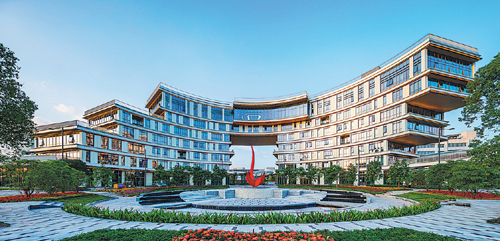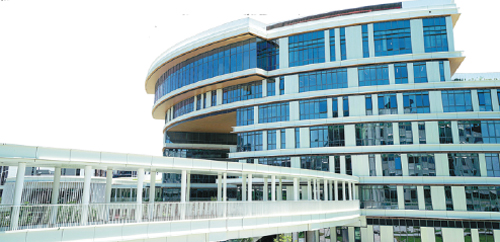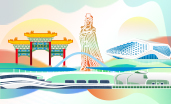District collaborates with university to promote innovation
Nansha district in Guangzhou, Guangdong province, is joining forces with the Hong Kong University of Science and Technology (Guangzhou), which started its first semester on Thursday, to share their strengths and promote scientific and technological innovation in the Guangdong-Hong Kong-Macao Greater Bay Area.
HKUST, one of the trailblazers in Nansha, took part in the construction of the Nansha Information Technology Park in 2003 and established the Guangzhou HKUST Fok Ying Tung Research Institute in 2007. The institute so far has served more than 300 enterprises in the Bay Area on key technology research and development and obtained nearly 200 invention patents.
Lionel Ni, president of HKUST(Guangzhou), said the university's development will be oriented towards Nansha and connected with Hong Kong. It will rely on the established manufacturing industries in the Bay Area, seize the opportunity of comprehensive cooperation among Nansha, Hong Kong and Macao, and focus on transforming knowledge into products.

The Hong Kong University of Science and Technology (Guangzhou) opens on Sept 1 in Nansha district. CHINA DAILY
Ni added the university will serve to complement the scientific and technological innovation collaboration between Nansha and Hong Kong and help build an innovation base for science and technology industries in the Bay Area.
The Overall Plan for Promoting Comprehensive Cooperation among Guangdong, Hong Kong and Macao by Further Deepening Opening-up in Nansha District of Guangzhou was released by the State Council, China's Cabinet, on June 14.
According to the plan, the major tasks for Nansha's future development include the construction of an innovation base for scientific and technological industry by joining forces with Hong Kong and Macao, the development of high-tech industries, the creation of a major scientific and technological innovation platform, and the promotion of international high-end talents.
Ouyang Jianhua, deputy head of Nansha district government, said HKUST (Guangzhou) is a major undertaking that showcases Nansha's collaboration with Hong Kong and Macao. It will buttress Nansha's development into a major world-oriented strategic platform rooted in the Bay Area and collaborating with Hong Kong and Macao, he added.
He said: "HKUST (Guangzhou) designs a curriculum that aligns with Nansha's scientific and technological innovation, which is expected to have spillover effects on related industries."
"HKUST (Guangzhou) will boost the flow of talents, capital, scientific and technological innovation across Hong Kong and Macao."
Zhu Gang, chief engineer of Nansha district's science and technology bureau, said that Nansha has progressed in the construction of innovation platforms. For example, Nansha and the Chinese Academy of Sciences are jointly building the Nansha Science City, which will be the main base of the comprehensive national science center in the Bay Area. Its core-the Guangzhou Mingzhu Science Park-will finish construction by the end of this year.

A raised walkway offers students convenient access to the modern buildings. CHINA DAILY
The Southern Marine Science and Engineering Guangdong Laboratory (Guangzhou), focusing on the sustainable use of marine resources and ecological sustainable development, is scheduled to be completed within this year.
In Nansha, a cold-seep ecosystem is listed in the nation's 14th Five-Year Plan (2021-25). Projects such as a hypersonic wind tunnel, facilities for marine research expeditions and drilling ships are making headway steadily.
Data from the Nansha district's science and technology bureau show that during the 13th Five-Year Plan (2016-20), the R&D investment intensity, that is the percentage of revenue reinvested in R&D, reached 3.67 percent. The number of patents granted increased by 5.5 times and the number of high-tech enterprises surged eight times.
Nansha is home to 23 research institutions. It has four provincial high-level innovation institutes, accounting for one-third of Guangzhou's total, and 14 provincial-level new R&D institutions, taking up about 20 percent of the city's total. A total of 128 innovation platforms have been built, which have promoted breakthroughs in major scientific and technological infrastructure.
All rights reserved. Presented by China Daily









